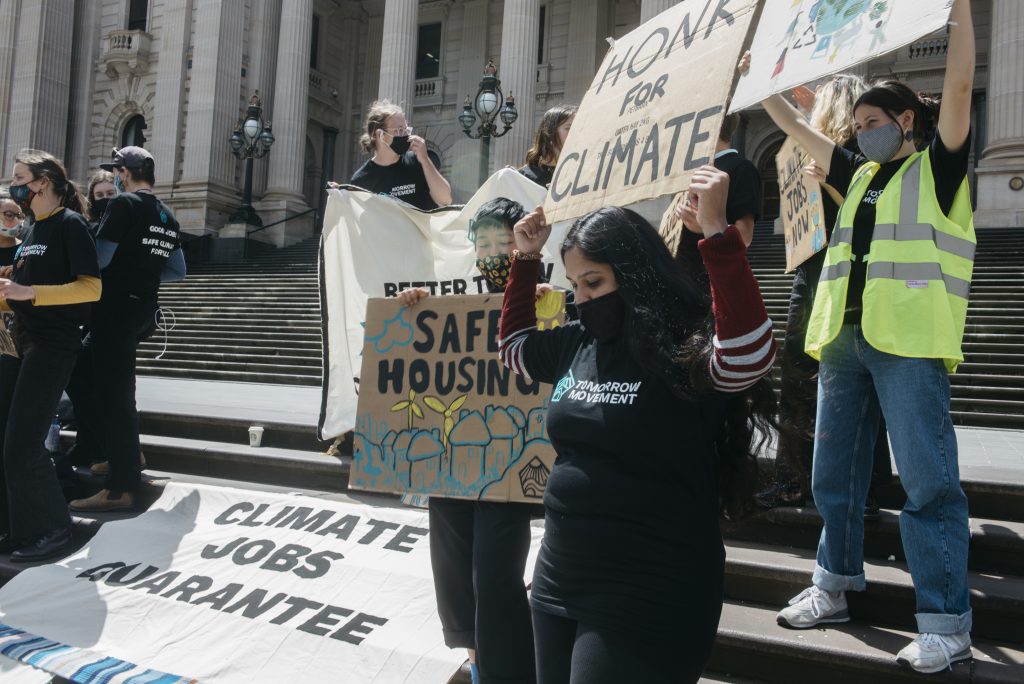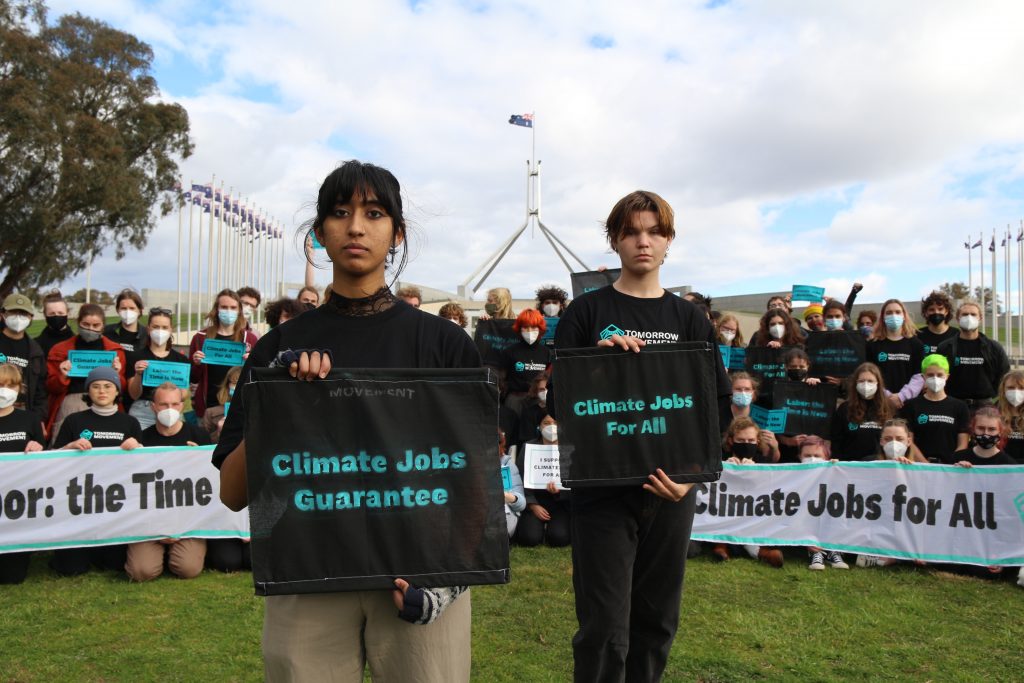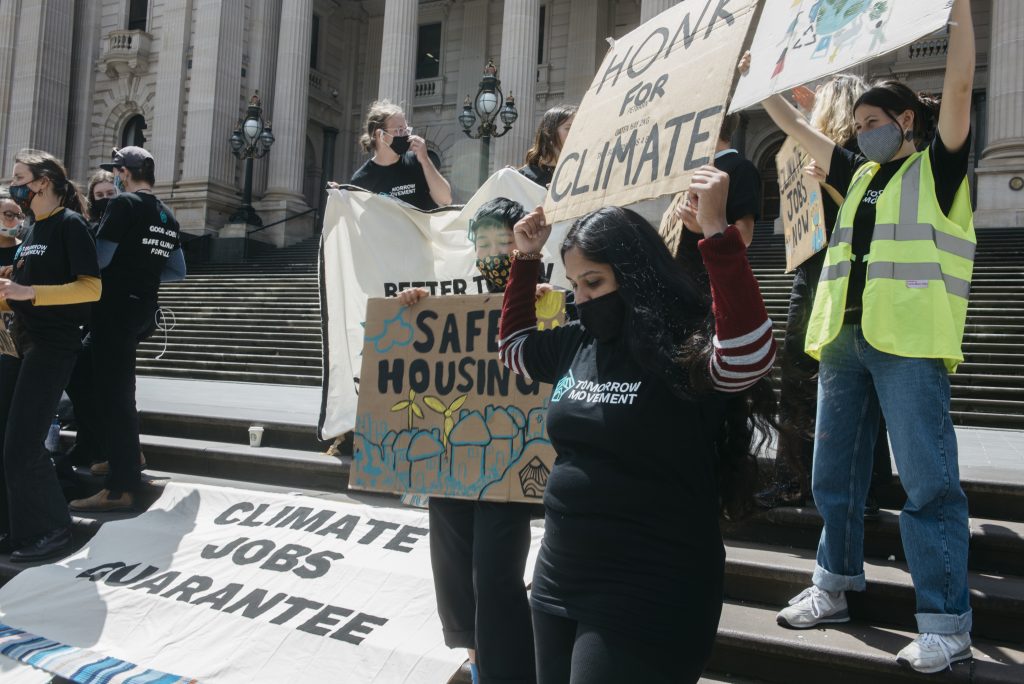In a world of climate collapse, what and who is work for? We can’t solve the climate crisis if big business continues to decide what work we do. Instead we need to take public control of what work gets done and the conditions that we work under. A Climate Jobs Guarantee could deliver meaningful and dignified work decided by communities, solving the challenges we face.
Introduction
As the climate collapses, the wealth gap widens and health crises cascade, there is no shortage of work to do redesigning our economies, protecting our homes and caring for our communities. And there are so many of us who want to get to work solving these challenges.
So if there is no shortage of meaningful work to do and no shortage of workers to do it – what’s the problem?
The climate crisis and the scale of transformation required to address it, demands we reimagine what work looks like and who gets to decide what work gets done.
A growing movement of young people, fighting under the banner of the Tomorrow Movement are campaigning for a Climate Jobs Guarantee, a policy agenda that will match the scale of the climate and jobs crisis. By rebuilding the public service, giving local communities a real stake in the work that gets done, and by finding meaningful work for anyone who wants it we can build a tomorrow that works for everyone instead of just big business.
In this piece I will explore:
- what the climate crisis means for work
- a short history of the jobs guarantee
- the core ideas underpinning The Climate Jobs Guarantee
- what it means for work to be decided by communities and for communities
- how we could win this transformational agenda

(1) We’re not working on solving the problem
Let’s not belabour the point – the climate science is very clear. The IPCC says we are in a code red emergency and there is no time to waste if we want to maintain the climatic conditions that have sustained human life for millennia. The warning sirens have been ringing for decades, but the world has failed to act. Not because we can’t agree on what needs to be done (rapid decarbonisation and immediate preparations to survive the impacts already locked in) but because those with the power to act have made deliberate choices not to do it. The fossil fuel industry has actively buried evidence of climate change for years and run horrifyingly successful campaigns to shift the focus away from their planet destroying profit model. Global north governments have been happy to swallow these lines to avoid taking action that would challenge the colonial and capitalist logic that has afforded them power and stability for so long.
It’s clear that the end result of the white supremacist and capitalist order is our collective, violent destruction; so we need another way. We need to immediately stop working on projects that are killing the planet and each other, and get to work protecting what is left while we still can.
We are talking about transformational change. It’s too late to tinker around the edges. Subtle interventions in the market won’t work in time, and because they leave power in the hands of big business. Market nudges can’t be trusted to provide for workers and communities. It’s time to take the keys off the people who are driving us into the sea.
Acknowledging the root causes of the climate crisis as capitalism and white supremacy, means we must use the solutions as an opportunity to address historic injustice and put the communities who have been most marginalised by these violent systems in the driver’s seat of economic transformation.
Appreciating this read? Be sure to CHIP IN to help fund future articles from Green Agenda.
There is no shortage of work to do. Emissions must be cut, industries need to be switched to clean energy. Homes, towns and cities need to be protected from heatwaves, fires and floods. Food, transportation and healthcare systems need to be bolstered to serve the needs of communities facing increasingly chaotic conditions. But most of us aren’t able to work on the urgent problems our society and communities are facing. Instead, most of us are forced into a labour market where we are put to work to enable corporations to make record profits while our real wages continue to fall. A punitive unemployment system ensures that the threat of unemployment keeps workers locked in this system, as those unable to find work are kept in a cycle of poverty and desperation by a system designed to discipline, rather than help unemployed people.
There is still time to prevent catastrophe and build a better society for all of us, but only if we get to work right away.

2) A short history of the jobs guarantee in Australia:
A federal Jobs Guarantee is not a new idea in Australia. In fact we had something very similar operating from 1945 to 1974 when the federal government maintained a commitment to full employment.
The 1945 White Paper on Full Employment declared that “in peace-time the responsibility of Commonwealth and State Governments is to provide the general framework of a full employment economy, within which the operations of individuals and businesses can be carried on.” For workers this system promised: “steady employment, the opportunity to change his [sic] employment if he [sic] wishes, and a secure prospect unmarred by the fear of idleness and the dole.” The policy aimed to achieve objectives of “improved nutrition, rural amenities and social services, more houses, factories and other capital equipment and higher standards of living generally.”
For a time these objectives were achieved through the Commonwealth Employment Service (CES), established to locate labour shortages and help people find work. Labour economist and former CES employee Dr Victor Quirk described the peak years of the CES as a “golden age” because it spanned the country and could operate as what Jay Coonan calls “a real-time labour-market intelligence network spanning the entire continent, collecting information on the ground, and transmitting it to state and federal offices.” This contributed to a fairer experience for workers because the CES would not fill vacancies for employers with a history of mistreating workers.
University of Adelaide’s Dr Steven Hail, attributed the policy to driving the most successful decades in Australian economic history.
The economy grew faster than ever before or since. Inequality and relative poverty continued to fall. Genuine full employment was maintained for thirty years, with the unemployment rate typically between 1 and 2%.
With the embrace of neo-liberalism in the late 1980s and 1990s, Australia’s commitment to full employment was abandoned. By 1998 John Howard’s government had fully privatised employment services.
It’s important to note the CES was not perfect, it maintained coercive work tests, and the prosperity enjoyed through the “golden years” of full employment was not enjoyed by politically and economically marginalised groups, including First Nations peoples, women and non-white migrants. This is a common story across western countries, in the US, where black communities had not experienced the benefits of the New Deal, a jobs guarantee became a core civil rights demand of the 1963 March on Washington. Because economic justice is a core component in the fight for racial justice, Coretta Scott King went on to lead a grassroots movement for a job guarantee after her husband, Reverend Martin Luther King Jr.’s death.
Job Guarantee programs have been implemented in many other jurisdictions, including Argentina, India, Sweden and the United States, in most cases for a short period of time in response to a crisis. The European Union’s Reinforced Youth Guarantee has seen over 24 million young people secure an offer of employment, continued education, apprenticeship or traineeship. A report conducted 3 years after the program launched found that there are 1.4 million fewer young people experiencing unemployment in the EU.
3) A guaranteed job building a more sustainable and caring society
Young people are leading the fight for a Climate Jobs Guarantee in Australia because we are on the frontlines of the climate and jobs crisis. In 2020, I was part of a founding team of 13 young people who set up the Tomorrow Movement as a people-powered vehicle for this campaign. We embarked on this process, in the wake of the 2019 election, when we felt the country was more divided than ever on the false idea that good jobs and a safe climate were somehow in conflict. As under-employed young people, with no housing security and no way to think about the future that didn’t involve the climate crisis – we knew we needed a climate movement that was resilient to this fracture point.
In 2021 we surveyed over 750 young people and found that:
- 65% were experiencing employment stress (unemployed or insecure work). This trend was worse for rural and regional respondents, with 74% either unemployed or in insecure work.
- 60% thought a jobs guarantee, similar to the Youth Jobs Guarantee in Europe, would solve the employment issues that they had personally experienced.
- Most young people think the government should prioritise creating jobs in Renewable Energy and the Care Economy including Education, Health & Age Care.
- 94% support a Climate Jobs Guarantee to create stable jobs for everyone who needs one in areas that serve the community’s needs, from renewable energy to housing and health services.
The members of Tomorrow Movement are building the power to win public and political support for this transformative idea. But turning this idea into reality is going to take more than just us. To guide the conversation we developed five criteria for what any Climate Jobs Guarantee proposal must meet to get our movement’s support.
- Good jobs for everyone who wants one: Millions of people can’t find as much work as they want and the threat of unemployment is used by big business to force people to accept poorly paid and insecure working conditions. A Climate Jobs Guarantee must guarantee anyone — regardless of age, education levels or location — a permanent, unionised job that pays a living wage. These jobs will have leave entitlements and can be full or part-time based on the needs of the person looking for work, raising the standards of work for all workers.
- Urgent, coordinated action to solve the climate crisis: The climate crisis is the fight of our lives and there is no shortage of work to be done for the urgent, large-scale action that’s needed to solve it. The jobs created by a Climate Jobs Guarantee must be meaningful work that enrich and serve our communities, reaching 100% clean and renewable energy by 2030 and managing the climate impacts we can no longer avoid.
- Meaningful work that cares for our communities as decided by our communities: The people who best know what kind of work their communities need are the people who live there. This program should be administered locally so that these jobs serve real needs in communities. In particular, First Nations Communities must have control over what work happens on their Country.
- Public service jobs in the hands of the public: For too long, the needs of big business have been put ahead of the needs of our society. This is our chance to rebuild the public sector to provide great public services that meet everyone’s needs and revitalise our cities, towns and communities. The jobs created by a Climate Jobs Guarantee must be public sector jobs that serve real community needs.
- A living income for all, whether people are working or not: A Climate Job Guarantee must not come at the expense of income support for everyone else. Everyone, whether they work or not, is entitled to the dignity of a living income and the support they need.

4) For our communities as decided by our communities
Ensuring communities, especially those on the frontlines of the climate crisis are genuinely in the driver’s seat of economic transformation is fundamental to achieving climate justice. People know what problems their communities face and what work is needed to solve them. Top down or market driven programs will either fail or re-assert extractive power dynamics.
There is a big difference between acknowledging communities should have a say in deciding what work will be done and properly resourcing them to do it. This is where the role of the state comes in and the inherent tension that comes with it. This tension is particularly acute when the lens of First Nations Sovereignty is applied. There can be no compromise that First Nations communities must be able to exercise sovereign control over their country. It falls on all of us to fight for a stronger democracy capable of recognising First Nations sovereignty and fully enfranchising the people and communities that are currently shut out of genuine decision making.
Appreciating this read? Be sure to CHIP IN to help fund future articles from Green Agenda.
Market led clean energy transformations have failed to prioritise projects, jobs and services to communities that need them most. As inequality deepens and the pace of climate change quickens these problems will only be exacerbated. Homes and regions will become unlivable, our workplaces will become increasingly unsafe and respite and care will become harder to find.
The logic of the market and the principles of justice have not and will not align in the climate crisis. Many communities are already innovating and leading solutions themselves, but without significant resourcing they won’t reach the speed and scale needed. We need a program of targeted government spending that can direct project funding to communities and regions on the frontlines.
There are some incredible community led initiatives that provide an insight into what genuine community leadership of a Climate Jobs Guarantee could look like.
The First Nations Clean Energy Network is ensuring First Nations people play a central role in Australia’s renewable energy development. The network is made up of First Nations people, communities and organisations, and collaborates with industry, investors, unions, academics, and technical experts. Their priorities include supporting community owned renewable energy projects, securing good job opportunities on Country, and forming strong industry partnerships where the benefits of renewables are genuinely shared. Steering Group member and Director of Original Power, Karrina Nolan says “It’s our lands and borders that will be impacted and the consent and involvement of our traditional owners is going to make or break that transition.” National Native Council chair Kado Muir (also on the Network’s Steering Committee) highlights the difference the network can make in the transition:
“Indigenous peoples’ estate is under siege with the expectation their involvement ends in handing over their land for big development projects… This is an old and outdated way of thinking. We want to be active participants in the economy of renewable energy, as owners of projects, technology and power distribution into markets.
The Victorian government has just announced a Jobs Guarantee for community services. Recognising the need for skilled workers in key sectors including disability and domestic violence, the program guarantees all students who graduate in the next two years with a community services diploma a job. This program represents a step towards guaranteeing people work in the areas of need felt most acutely by our communities. There is huge scope for its expansion, if it follows the direction of the program recipients and communities most in need of services, jobs and projects.
While these examples show how a Climate Job Guarantee could be delivered, these are still far too small in scale and lack the national coordination to solve the climate crisis and truly deliver good jobs and great public services for all of our communities.
The Climate Jobs Guarantee must be a means not just of rapidly cutting emissions, but of deeply investing in communities. For communities to be truly in control of this process, it must be federally funded but locally administered. There is no doubt there are flaws in our local democratic systems but a transformation of this scale and importance only provides more motivation to work towards strengthening our democracy. We must make it more possible for people who have been most excluded from our current economy, by language, class, disability, gender, visa status and more, to play an active role in deciding what happens in our communities. It is up to all of us to work towards a fuller economic franchise. Councillor Johnathan Sri’s experiments with participatory budgeting in the Gabba ward of Brisbane involving direct votes and consensus based participatory design projects, shows that the public’s appetite for engaging deeper in democratic projects is strong, and leads to better outcomes for communities.
“Feedback from participating residents has been overwhelmingly positive. By decentralising decision-making power and involving people who are directly impacted by decisions, we get higher-quality outcomes that are more responsive to localised needs.”
There are many people already working on solving the question of “how will we shift to 100% clean energy?” But there are so many other big questions we still need to answer. How will we feed ourselves as the temperature rises and crops fail? What does zero emission domestic and international travel look like? How do we end homelessness? How can we care for each other’s mental health in a world that is increasingly traumatic?
It is precisely because the challenges that we need to solve are so large that we need to be enabling as many people as possible to work on the solutions. I don’t intend in this article to suggest that I have any definitive or non-problematic answers, or even that a single perfect answer does exist, but rather to pose a provocation and an invitation for as many people as possible to get involved in the messy business of bringing about the future. This future demands new ideas, new skills and new thinkers and doers, and our imagination must not be limited to what is already on offer in the current neo-liberal paradigm.
5) How can we advance and win this idea?
The fossil fuel lobby has successfully driven a wedge between cost of living and a safe climate, delaying climate policy in Australia for many years. Last time federal Labor held government, with a strong Greens and Independent crossbench, the fossil fuel lobby managed to kill the Clean Energy Act. Enlisting opposition Leader, Tony Abbott, to relentlessly run lines about how the “Carbon Price was going to cost families $550 a year, and cause job losses.” These claims were untrue but incredibly effective and oft repeated by the media.
We need a vision for climate policy that is resilient to these right wing attacks. We can do this by tying the urgent task of decarbonisation to material improvements in all of our lives. We can’t build this type of vision, let alone the political power to win it, without the active participation of the communities who are most directly impacted by both the impacts of climate change and the economic transition that is upon us.
The fossil fuel industry isn’t going down without a fight, they will keep working to divide and distract us. We have to come back stronger, with bigger, more inclusive and transformative ideas that can win the support of large swathes of the population. Work is a significant part of people’s lives and is, as it has always been, deeply political. We need a collectively owned vision for the future of work that is more exciting, meaningful and powerful than the might of the fossil fuel lobby.
The Climate Jobs Guarantee has the potential to be a popular and transformative policy agenda that matches the scale of the climate and economic crisis. Acting on climate change is not a choice between cutting emissions and solving urgent problems in our communities. We can and must do both. There are so many people who don’t have enough work and who want to get to work making our communities stronger.
Solving this crisis will require thousands of nation-building projects that could guarantee good quality jobs decarbonising every industry and caring for our communities. These could be large-scale infrastructure projects like building new train lines connecting our cities, and transmission lines re-inventing the electricity grid. It could be building and retrofitting millions of energy-efficient homes. It could be resourcing First Nations communities to care for Country and have sovereign control over what happens on their land. It could be training and staffing hundreds more nurses, aged care and support workers as we face future pressures on the health system.
We can build a future with good jobs, great public services and a safe climate for everyone with a Climate Jobs Guarantee. If the public gets to decide what work gets done rather than big business, the imagination and capacity of our communities is the only limit.
If you appreciated the read, be sure to CHIP IN, even as little as $5, to help fund future articles.
Cat Nadel is a co-founder and National Director of Tomorrow Movement, a movement of young people fighting to end the influence of big business on our politics so that we can win a tomorrow with good jobs, great public services and a safe climate for all. Cat got her first taste of community organising as a student leader in the successful campaign to get Monash University to divest $450 million from coal. Cat spent four years as a climate campaigner at Environment Victoria where she worked with communities in the Latrobe Valley, Westernport Bay and suburban Melbourne to build power for stronger climate policies and a just transition. Cat grew up on the banks of the Maribyrnong River, on Wurundjeri country, and still lives and works in Naarm / Melbourne.
The featured image at the beginning of the article is by photographer Kaede James Takamoto.


One thought on “Who decides? The case for a Climate Jobs Guarantee ”